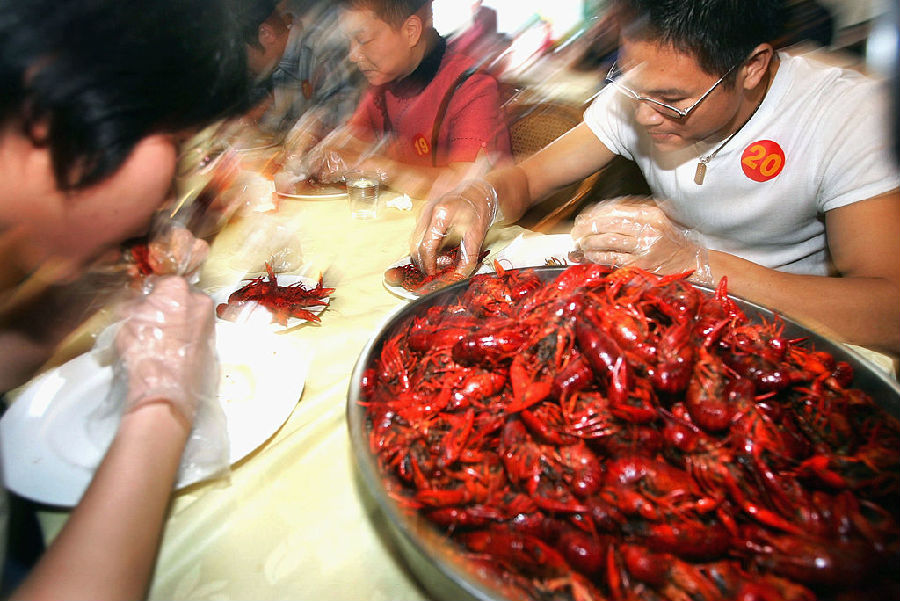(单词翻译:单击)
One in eight residents in Xuyi county, in eastern China’s Jiangsu province, works in the crayfish industry, and the signs are visible everywhere.
江苏省盱眙县八分之一的居民在小龙虾行业工作,小龙虾的形象在这座县城随处可见。
Chinese diners hungry for fresh seafood and eager for an unconventional dining experience are gobbling up crayfish, spurring an economic bonanza for once-impoverished rural counties, where farmers have developed new cultivation techniques to satisfy demand.
那些爱吃新鲜海鲜且渴望非传统就餐体验的中国食客正沉迷于小龙虾的盛宴,这为一些曾经贫困的农村带来了一个致富机遇,这里的农民们开发了新的养殖技术以满足需求。
Yang Weiwei, general manager of Xuyi Power Faction Ecological Agriculture Development, one of the largest producers and distributors in Xuyi, takes pains to describe why Jiangsu crayfish are superior to those from rival provinces such as Hubei, Jiangxi and Anhui.
盱眙一家生态农业公司的总经理杨维伟(音译)是盱眙最大的生产和经销商之一,他竭力解释为什么江苏的小龙虾要胜过湖北、江西和安徽等竞争省份的小龙虾。
“Hubei craws have big heads and small tails, so the edible part is small. Anhui craws are the lowest quality of all. Their cheeks are black, which means they’re not clean,” Mr Yang says over a dinner of crayfish and baijiu, the clear Chinese spirit. “Jiangxi mostly has green craws. Their shells are soft, so they’re not suitable for shipping. The death rate is high.”
杨维伟对着晚餐上的龙虾和白酒说到:“湖北虾头大,尾巴小,可食部分少。安徽虾质量最差,虾鳃是黑色的,这说明它们不干净。江西大多是青壳虾,它们的壳很软,所以不适合运输,死亡率很高。”
Production of crayfish more than tripled in China from 2007 to 850,000 tonnes last year, according to a report on the industry commissioned by the ministry of agriculture.
根据中国农业部委托的一份行业报告,去年中国小龙虾产量达到85万吨,是2007年的三倍多。
As Chinese policymakers seek to promote domestic consumption in order to reduce the economy’s reliance on fixed-asset investment and exports, the growth of industries such as crayfish is a welcome development.
随着中国的政策制定者力图促进国内消费,以减少经济对固定资产投资和出口的依赖,小龙虾等行业的增长是一个可喜的发展。
Affluent urbanites enjoy the ritual of donning plastic gloves to peel and eat the critters, which are typically slathered in a spicy sauce. Some note that the sauce-drenched gloves prevent fellow diners from checking their mobile phones during a group meal, encouraging social interaction. The restaurants typically stay open late at night, the aroma drawing in revellers.
富裕的城市居民享受着吃小龙虾的仪式,他们戴好塑料手套,剥去小龙虾的外壳,然后开吃。小龙虾通常泡在浓稠的辣酱里,有些人注意到在团体聚餐中,沾满酱汁的手套妨碍了同桌食客查看手机,从而鼓励了社交互动。小龙虾餐馆通常开到深夜,扑鼻的香气引来了狂欢的人群。
A breakthrough for China’s crayfish came in the late 1990s, when connoisseurs developed ways to add flavour. Previously, they were mostly boiled in salt water, leading to a bland flavour.
中国小龙虾行业在20世纪90年代后期迎来突破,当时的行家们开发了种种增添风味的方法。之前的方法大多是用盐水煮,味道较平淡。
Mr Yang, whose parent company also produces seasonings, claims that Xuyi is home to the original “13 flavours” recipe, which is now widely used to create the classic reddish broth. Despite the name, the sauce is made from 32 herbs and spices.
杨维伟的母公司也生产调味品,他说盱眙是“十三香”做法的发源地。虽然名字叫十三香,其实这种酱汁是由32种草药和香料制成的。
Another boon for the industry came around the same time, when Liu Zhuquan, a village official in Hubei province responsible for agricultural development, pioneered a new technique for cultivating crayfish. Mr Liu realised that rice paddies, with thick grass, plentiful water, and reliable drainage, were an ideal environment for crayfish.
大概在同一时间,小龙虾行业迎来了另一个利好。当时一位名叫刘主权的湖北省负责农业发展的村官率先开创了养殖小龙虾的新技术。刘主权发现稻草茂密、水量充足、排水可靠的稻田是小龙虾的理想环境。
“At that time, the village was in bad shape. Grain prices were low, and a lot of fields were left fallow because farmers couldn’t even cover their costs,” he said. “I had a feeling like I wanted to help farmers bust out of their rut.”
刘主权说:“那时候农村的情况不太好。粮食价格很低,大量农田被休耕,因为农民们连种地的成本都担负不起。我那时就想帮助农民摆脱这一困境。”
The industry is ideal for regions that had missed out on China’s economic boom, which was based on manufacturing, construction and heavy industry.
该行业对于那些错过了中国以制造业、建筑业和重工业为基础的经济繁荣的地区是一个理想选择。
Xuyi county’s Hongze Lake is one of the largest in China but is mostly free from the industrial pollution that plagues some other Chinese water systems. The animal’s naturally short lifespan — a brood can mature from eggs to full-grown in two months — means there is little need for hormones to promote growth.
盱眙县洪泽湖是中国最大的淡水湖之一,而且基本没有受到工业污染,不像中国其他一些深受污染困扰的水系。小龙虾自然寿命很短,一窝虾从卵到生长完全只需两个月,这意味着几乎无需添加激素以促进生长。

When it is time to harvest, farmers send bubbles through the water to engorge their stomachs with gas, then force them to drink water. The crayfish vomit, leaving their stomachs clean and white.
到了收获的时候,农民们会往水里注入气泡,用气体充满小龙虾的腹部,迫使它们喝水。随后小龙虾会吐出腹部的水,其腹内变得干净洁白。
The industry has apparently been good to Xuyi. Mr Yang drives an Audi, and similar vehicles dot the parking lot at the flagship restaurant owned by Sizhou City Agricultural Development, his parent company.
这个行业显然利于盱眙的发展。杨维伟驾驶着一辆奥迪,他的母公司盱眙泗州城农业发展(Sizhou City Agricultural Development)旗下旗舰餐厅的停车场里也停满了奥迪。
The city is burgeoning with new construction, and the region’s gross domestic product has grown by a yearly average of 15.1 per cent in nominal terms from 2011 to 2016, compared with the national average of 10.4 per cent.
盱眙正迅速建起大批新建筑,2011年至2016年该地区的国内生产总值(GDP)按名义价值计算年均增长了15.1%,而全国平均水平为10.4%。
In a sign of its ambition, Sizhou City Agricultural has even invested in a film, My Kitchen Lover
泗州城农业发展甚至投资了一部电影,《泡菜爱上小龙虾》(My Kitchen Lover ),以促进该行业发展,显示了该公司的抱负。本片计划于今年8月在全国影院上映。“这部影片讲的是韩国辣白菜爱上了中国小龙虾。我们请到了几位功夫巨星出演。”


